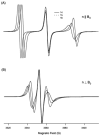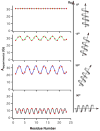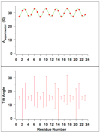Determining the helical tilt of membrane peptides using electron paramagnetic resonance spectroscopy
- PMID: 19254856
- PMCID: PMC2666113
- DOI: 10.1016/j.jmr.2008.12.007
Determining the helical tilt of membrane peptides using electron paramagnetic resonance spectroscopy
Abstract
Theoretical calculations of hyperfine splitting values derived from the EPR spectra of TOAC spin-labeled rigid aligned alpha-helical membrane peptides reveal a unique periodic variation. In the absence of helical motion, a plot of the corresponding hyperfine splitting values as a function of residue number results in a sinusoidal curve that depends on the helical tilt angle that the peptide makes with respect to the magnetic field. Motion about the long helical axis reduces the amplitude of the curve and averages out the corresponding hyperfine splitting values. The corresponding spectra can be used to determine the director axis tilt angle from the TOAC spin label, which can be used to calculate the helical tilt angle due to the rigidity of the TOAC spin label. Additionally, this paper describes a method to experimentally determine this helical tilt angle from the hyperfine splitting values of three consecutive residues.
Figures






Similar articles
-
Determining the topology of integral membrane peptides using EPR spectroscopy.J Am Chem Soc. 2006 Jul 26;128(29):9549-54. doi: 10.1021/ja0622204. J Am Chem Soc. 2006. PMID: 16848493 Free PMC article.
-
Conformation and EPR characterization of rigid, 310 -helical peptides with TOAC spin labels: Models for short distances.Biopolymers. 2014 May;102(3):244-51. doi: 10.1002/bip.22467. Biopolymers. 2014. PMID: 24488683
-
Determining the helical tilt angle and dynamic properties of the transmembrane domains of pinholin S2168 using mechanical alignment EPR spectroscopy.Biochim Biophys Acta Biomembr. 2023 Jun;1865(5):184154. doi: 10.1016/j.bbamem.2023.184154. Epub 2023 Apr 5. Biochim Biophys Acta Biomembr. 2023. PMID: 37023970
-
Studies of transmembrane peptides by pulse dipolar spectroscopy with semi-rigid TOPP spin labels.Eur Biophys J. 2021 Mar;50(2):143-157. doi: 10.1007/s00249-021-01508-6. Epub 2021 Feb 28. Eur Biophys J. 2021. PMID: 33640998 Free PMC article. Review.
-
Exploring the peptide 3(10)-helix reversible alpha-helix equilibrium with double label electron spin resonance.Biopolymers. 1995;37(4):243-50. doi: 10.1002/bip.360370403. Biopolymers. 1995. PMID: 7780027 Review.
Cited by
-
When detergent meets bilayer: birth and coming of age of lipid bicelles.Prog Nucl Magn Reson Spectrosc. 2013 Feb;69:1-22. doi: 10.1016/j.pnmrs.2013.01.001. Epub 2013 Jan 23. Prog Nucl Magn Reson Spectrosc. 2013. PMID: 23465641 Free PMC article. Review. No abstract available.
-
Probing the Secondary Structure of Membrane Peptides Using (2)H-Labeled d(10)-Leucine via Site-Directed Spin-Labeling and Electron Spin Echo Envelope Modulation Spectroscopy.J Phys Chem B. 2016 Feb 4;120(4):633-40. doi: 10.1021/acs.jpcb.5b09040. Epub 2016 Jan 20. J Phys Chem B. 2016. PMID: 26735335 Free PMC article.
-
Determining the orientation and localization of membrane-bound peptides.Curr Protein Pept Sci. 2012 May;13(3):267-79. doi: 10.2174/138920312800785049. Curr Protein Pept Sci. 2012. PMID: 22044140 Free PMC article. Review.
-
The magic of bicelles lights up membrane protein structure.Chem Rev. 2012 Nov 14;112(11):6054-74. doi: 10.1021/cr300061w. Epub 2012 Aug 24. Chem Rev. 2012. PMID: 22920148 Free PMC article. Review. No abstract available.
-
Probing topology and dynamics of the second transmembrane domain (M2δ) of the acetyl choline receptor using magnetically aligned lipid bilayers (bicelles) and EPR spectroscopy.Chem Phys Lipids. 2017 Aug;206:9-15. doi: 10.1016/j.chemphyslip.2017.05.010. Epub 2017 May 29. Chem Phys Lipids. 2017. PMID: 28571787 Free PMC article.
References
-
- Arkin IT, MacKenzie KR, Fisher L, Aimoto S, Engelman DM, Smith SO. Mapping the lipid-exposed surfaces of membrane proteins. Nat Struct Biol. 1996;3:240–243. - PubMed
-
- Nagy JK, Lau FW, Bowie JU, Sanders CR. Mapping the oligomeric interface of diacylglycerol kinase by engineered thiol cross-linking: Homologous sites in the transmembrane domain. Biochemistry. 2000;39:4154–4164. - PubMed
-
- Doyle DA, Cabral JM, Pfuetzner RA, Kuo AL, Gulbis JM, Cohen SL, Chait BT, MacKinnon R. The structure of the potassium channel: Molecular basis of K+ conduction and selectivity. Science. 1998;280:69–77. - PubMed
-
- Fu DX, Libson A, Miercke LJW, Weitzman C, Nollert P, Krucinski J, Stroud RM. Structure of a glycerol-conducting channel and the basis for its selectivity. Science. 2000;290:481–486. - PubMed
Publication types
MeSH terms
Substances
Grants and funding
LinkOut - more resources
Full Text Sources

